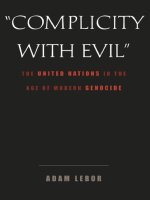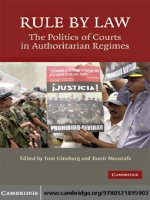yale university press complicity with evil the united nations in the age of modern genocide nov 2006 ebook-pt
Bạn đang xem bản rút gọn của tài liệu. Xem và tải ngay bản đầy đủ của tài liệu tại đây (2.69 MB, 349 trang )
“Complicity with Evil”
by the same author
A Heart Turned East:
Among the Muslims of Europe and America
Hitler’s Secret Bankers:
The Myth of Swiss Neutrality During the Holocaust
Seduced by Hitler:
The Choices of a Nation and the Ethics of Survival
Milosevic: A Biography
City of Oranges:
Arabs and Jews in Jaffa
“Complicity
with Evil”
The United Nations in the
Age of Modern Genocide
Adam LeBor
Yale University Press New Haven & London
Copyright © 2006 by Adam LeBor.
All rights reserved.
This book may not be reproduced, in whole or in part, including illustrations,
in any form (beyond that copying permitted by Sections 107 and 108 of the U.S.
Copyright Law and except by reviewers for the public press), without written
permission from the publishers.
Set in Minion Roman type by Integrated Publishing Solutions.
Printed in the United States of America by R. R. Donnelley, Harrisburg,
Virginia.
Library of Congress Cataloging-in-Publication Data
LeBor, Adam.
“Complicity with evil” : the United Nations in the age of modern genocide /
Adam LeBor.
p. cm.
Includes bibliographical references and index.
ISBN-13: 978-0-300-11171-2 (cloth : alk. paper)
ISBN-10: 0-300-11171-1 (cloth : alk. paper)
1. United Nations. 2. United Nations. Secretariat. 3. Genocide. 4. Security,
International. I. Title. II. Title: United Nations in the age of modern genocide.
JZ4971.L43 2006
341.23—dc22 2006017319
A catalogue record for this book is available from the British Library.
The paper in this book meets the guidelines for permanence and durability of
the Committee on Production Guidelines for Book Longevity of the Council
on Library Resources.
10987654321
in memoriam
Z
.
ydowska Organizacja Bojowa
Z
.
ydowski Zwi≤zek Wojskowy
Warsaw Ghetto,
January–May 1943
No failure did more to damage the standing and credibility of
United Nations peacekeeping in the 1990s than its reluctance
to distinguish victim from aggressor.
—Executive summary of the United Nations 2000 report on
its peacekeeping operations
Contents
Preface ix
Acknowledgments xv
List of Abbreviations xviii
Introduction 1
Part I
one A Safe Area 23
two Master Drafters 44
three Countdown 71
four The Fall 92
five Recently Disturbed Earth 112
Part II
six Silence in the Secretariat 135
seven A Rwandan Reprise 157
eight Genocide, or Maybe Not 182
nine A Will and a Way 204
ten A Meager Reckoning 229
eleven Command Responsibility 254
Appendix 281
Notes 291
Select Bibliography 301
Index 307
viii Contents
Preface
This book takes its title,“Complicity with Evil,” from the United
Nations’report on its peacekeeping operations during the 1990s,
published in August 2000. The report was commissioned by
Secretary General Kofi Annan, who convened a high-level panel
of diplomats, military officers, and humanitarian officials with
experience of UN operations in crisis zones. The authors pro-
posed new approaches for peacekeeping after the failures in
Srebrenica and Rwanda, so as to confront the challenges of the
post–Cold War world of conflicts fought by rogue states and
anarchic militias. The report’s fifty-four pages contain a series
of detailed recommendations about the conduct of future op-
erations, and an outline of institutional and attitudinal changes
needed within member states, the Security Council, and the
Secretariat—the permanent body of UN officials—to make
peacekeeping more dynamic and effective. Probably the docu-
ment’s most important sentence is contained in its executive
summary: “Impartiality for United Nations operations must
therefore mean adherence to the principles of the Charter:
where one party clearly and incontrovertibly is violating its
terms, continued equal treatment of the parties by the United
Nations can in the best case result in ineffectiveness and in the
worst may amount to complicity with evil.”
This was certainly the case in both Srebrenica and
Rwanda, and remains so in Darfur. The Dutchbat battalion of
UNPROFOR, the UN protection force deployed in Croatia
and Bosnia, stationed in the UN-declared safe area of Sre-
brenica, was unable to prevent the fall of the town in July 1995
and the subsequent slaughter of up to 8,000 Bosniak (Bosnian
Muslim) men and boys. UNAMIR, the UN assistance mission
for Rwanda, failed to prevent the genocide of 800,000 Tutsis
and moderate Hutus during spring and early summer 1994,
despite the valiant efforts of its commander General Romeo
Dallaire. By spring 2006 the Sudanese government had been
waging a campaign of genocide across Darfur for three years,
but the United Nations had not even deployed peacekeepers
there, relying instead on a weak and underfunded mission of
African Union cease-fire monitors.
But do these actions really make the United Nations guilty
of complicity with evil? Complicity is an emotive term. The
dictionary defines it as “being an accomplice in a criminal act.”
Complicity can be active or passive. The United Nations did
not intentionally assist the Bosnian Serbs to kill the men and
boys of Srebrenica, the Hutu militias to slaughter their Tutsi
victims, or the Sudanese Janjaweed paramilitaries to burn the
villages of Darfur. UN peacekeepers are mandated to save lives,
not take them. Secretariat officials believed—and believe—
themselves to be acting with the best of intentions, steering the
United Nations through a perilous middle path of impartial-
ity and neutrality that by favoring neither side would allow the
organization to do the maximum good. When in January 1994
Kofi Annan, then head of the Department of Peacekeeping Op-
erations, refused General Dallaire permission to raid the Hutu
x Preface
arms caches, he believed that such an action was outside
UNAMIR’s mandate and would imperil both the United Na-
tions mission in Rwanda and the UN’s status as an impartial
interlocutor.
The members of the Security Council assumed, or at least
hoped, in spring 1993 that by passing resolutions declaring Sre-
brenica a UN-protected safe area, they were taking a meaning-
ful step to protect the innocent. A decade later, the failure of the
Security Council and the General Assembly to take any mean-
ingful action against the Sudanese government must be weighed
against the need to keep channels open to Sudan and so ensure
the continued operation of the United Nations’ humanitarian
operation in Darfur, which has saved hundreds of thousands
of lives.
Thus the argument for the defense. But there is another
definition of complicity, which is a nuanced as well as an emo-
tive term. To be complicit in a crime does not necessarily mean
actively aiding and abetting the perpetrators. It can also mean
failing to act on the knowledge that crimes are being, or are
likely to be, committed, or failing to try at least to prevent them
happening, despite having the means to do so. This is the prin-
ciple of “command responsibility” which has evolved through
the legal rulings of the UN’s own tribunals for the former
Yugoslavia and Rwanda. And this is the argument for the
prosecution. In this book I show that the United Nations was,
and remains, at the very least, passively complicit with evil: in
Bosnia from 1992 to 1995—nowhere more than at Srebrenica—
in Rwanda in 1994, and in Darfur since 2003.
After declaring Srebrenica a safe area, the Security Coun-
cil extended that status to another five Bosnian towns and cities,
yet its members—all of the UN member states—consistently
failed to provide enough troops to provide effective protec-
Preface xi
tion. UN commanders themselves repeatedly refused to autho-
rize NATO air strikes requested by Dutch UN peacekeepers at
Srebrenica, despite having both the mandate and the means to
do so, until it was too late to stop the Serb onslaught. When the
town finally fell, the Dutch UN troops ignored the pleas of
Bosniak men and boys who had taken refuge in their com-
pound and forced them into the hands of their Serb execution-
ers. Rwanda remained a UN member state during the genocide
there and even retained its seat on the Security Council, its am-
bassador privy to every discussion about how to stop the killings
his government was carrying out. As news of the slaughter
emerged, the Security Council, rather than reinforce UNAMIR,
actually reduced its force from 2,500 troops to 270. Sudan has
enjoyed all privileges of United Nations membership from the
start of its scorched-earth campaign in Darfur in 2003 to the
present day, and remained a member of the UN’s Commission
on Human Rights in 2003, 2004, and 2005. All of these decisions
ultimately resulted, whether intentionally or not, in complic-
ity with evil.
The United Nations’ defenders reject this. They argue that
the organization is merely the sum of its member states. If they
lack the political will or the economic and military means to
stop a conflict, then there is nothing the United Nations can
do. The world is increasingly complicated, this reasoning goes,
its political and diplomatic realities complex, especially after
the end of the Cold War—which, for all its faults, brought a
sense of stability and balance between the superpowers. The
United Nations itself is composed of competing interest groups
from the General Assembly through the Security Council, and
even within the Secretariat itself, and it is not the United Na-
tions’ fault that the international security mechanisms of 1945
have proved woefully inadequate for the challenges of the 1990s
xii Preface
and after. But what this means in practice is that if everyone is
guilty, then no one is guilty. If everyone is responsible, then no
one is responsible. This circular, convenient argument has un-
doubted appeal, not least to the consciences of those responsible
for the United Nations’ failures, from London and Paris to
Washington, D.C., and New York, including those working in
the United Nations building itself.
But it is not an adequate answer. If the United Nations,
whose very raison d’être is the maintenance of international
peace and security, does not bear some responsibility for fail-
ing to stop the slaughters in Srebrenica, Rwanda, and Darfur,
then who does? The United Nations is the primary instrument
through which the world makes its stuttering attempts to stop
genocide. It is the United Nations that attempted to ameliorate
the suffering in those three crises. Whatever factors shape the
United Nations’ inner dynamics, however responsibility is di-
vided among the Secretariat, the Security Council, and the
General Assembly, the United Nations exists and functions not
as merely the sum of these parts but as an institution itself, one
with a powerful, global, reach. The United Nations is more than
sixty years old. It has experience of dealing with conflict zones
from Asia to Latin America, from Africa to the Balkans. It has a
powerful institutional memory and considerable moral author-
ity—however battered by recent scandals; for many, it remains
the institutionalized hope of their dreams of a better world.
The United Nations is the crucial factor that links Sre-
brenica, Rwanda, and Darfur. In the past decade it has failed
twice to stop or prevent genocide, and it is still failing now. I
shall in this book detail the reasons for, and the price of, those
failures. They are more complex than the arguments that the
Secretariat is merely a vast human computer waiting to be pro-
grammed by its masters in the Security Council, the Security
Preface xiii
Council a mirror of the interests of the superpowers who
dominate its proceedings. I shall show how the repeating pat-
terns of appeasement of genocide that ultimately betrayed the
victims of Srebrenica and Rwanda still continue today in Dar-
fur. In this sense the United Nations, as its 2000 report on
peacekeeping shows, remains at least passively guilty of “com-
plicity with evil.” But this pattern can be broken, and I shall ex-
amine some proposals for doing so, including the United Na-
tions’ own. Recognizing this possibility, changing the way the
United Nations works, can only aid and accelerate the process
of making it an organization which can prevent and stop geno-
cide, as well as provide succor to its victims.
xiv Preface
Acknowledgments
My thanks go first of all to the numerous United Nations offi-
cials and international diplomats, both serving and retired, who
generously shared their knowledge and experience with me.
Some spoke off the record, but of those who can be named, I
am grateful to Madeleine Albright, André Erdo˝s, Peter Galbraith,
David Hannay, David Harland, Richard Holbrooke, Douglas
Hurd, Ed Joseph, Colin Keating, General Lewis Mackenzie,
Haile Menkerios, Jim O’Brien, David Owen, Pierre-Richard
Prosper, General Sir Michael Rose, Samir Sanbar, Shashi Tha-
roor, Danilo Türk, and especially Dr. Michael Williams. Diego
Arria and Mo Sacirbey were crucial sources in helping illumi-
nate the saga of the United Nations safe areas and its tragic de-
nouement in Srebrenica, while Dr. Mukesh Kapila brought
valuable insight into the UN’s response to the crisis in Darfur.
The United Nations press corps was welcoming and help-
ful to a new arrival on their territory, especially James Bone of
the Times of London, who readily shared his knowledge and
experience, Richard Roth and Elizabeth Neisloss of CNN, and
Maggie Farley of the Los Angeles Times. The Pulitzer Prize–
winning journalists Roy Gutman and David Rohde were very
generous with their advice, insight, and suggestions. I am grate-
ful to Patrick Bishop, Yigal Chazan, Justin Leighton, Sam Loe-
wenberg, Peter Maass, Mark Milstein, John Nadler, Brendan
Simms, and Julius Strauss, all of whom have helped with this
book and its themes over the years. Thanks also to Martin
Fletcher, Richard Beeston, Gill Ross, and Alice Fordham at the
Times of London, and to Heather Maher of Transitions Online
for a useful seminar on the International Criminal Court.
Philip Reeker and Janet Garvey kindly helped open numerous
doors in New York and Washington, D.C., as did Michael
Ward. Steve Crawshaw of Human Rights Watch was especially
helpful; so, too, were Peggy Hicks and Joanna Weschler, and
John Prendergast of the International Crisis Group. Bjørn
Willum generously supplied a copy of his insightful study of
the Secretariat’s response to the genocide in Rwanda.
Caroline Lam at the Liddell Hart Centre for Military
Archives at King’s College London and Pavol Salamon and
Niall Walsh at the Open Society Archives in Budapest helped
me obtain access to many important documents. Peter, Robert,
and Sara Green were warm and welcoming hosts in New York,
as was Philip Sherwell in Washington, D.C. Alec Russell and
Francis Harris generously let me set up camp in the Daily Tele-
graph’s Washington bureau, while Anna Meller and Kati Tordas
diligently transcribed numerous interviews. Adrian Brown, Tom
Gross, and Erwin Tuil provided many useful leads. Special thanks
to Chris Condon and Roger Boyes, for their encouragement,
support, and suggestions.
John Kulka, my editor at Yale University Press, has stead-
fastly kept faith with this project from its birth to publication.
His thoughtful input and careful guidance have been invaluable.
Thanks also to Dan Heaton, for his excellent copyediting, and
Lindsay Toland; to Robert Baldock, Anne Bihan, and Hazel
Hutchinson at Yale in London; and to Bill Swainson and Ruth
xvi Acknowledgments
Logan at Bloomsbury UK, who first published my biography
of Slobodan Milosˇeviª—a work which subsequently inspired
this book. My agent, Laura Longrigg, has, as ever, been a much-
valued source of advice and support, and thanks also to David
Riding. Most of all, my thanks go to my family for sustaining me
on a dark journey through recent history.
Acknowledgments xvii
Abbreviations
AMIS African (Union) Mission in Sudan
APC armored personnel carrier
AU African Union
CAS close air support (targeted air strikes, as opposed to
strategic bombing)
DPA Department of Political Affairs
DPI Department of Public Information
DPKO Department of Peacekeeping Operations
EC European Community (forerunner of the European
Union)
ESC Economics and Social Council
EU European Union
HRC Human Rights Council
ICC International Criminal Court
ICI International Commission of Inquiry (on Darfur)
ICJ International Court of Justice
ICRC International Committee of the Red Cross
ICTR International criminal tribunal for Rwanda
ICTY International criminal tribunal for the former
Yugoslavia
IDP internally displaced person (a refugee in one’s own
country)
JEM Justice and Equality Movement (rebel force in
Darfur)
JNA Yugoslav national army (Jugoslavenska Narodna
Armija)
MONUC United Nations Mission in Congo (Mission de
l’Organisation des Nations Unies en République
démocratique du Congo)
MSF Doctors Without Borders (Médecins Sans Frontières)
NAC Non-Aligned Caucus
NATO North Atlantic Treaty Organisation
NIF National Islamic Front
OCHA Office for the Coordination of Humanitarian
Affairs
OHCHR Office of the United Nations High Commissioner
for Refugees
OLA Office of Legal Affairs
OP observation post
PAIC Popular Arab and Islamic Conference
P5 shorthand for the five permanent members of the
Security Council: the United States, Great Britain,
France, Russia, and China
P3 shorthand for the United States, Great Britain, and
France
RPF Rwandan Patriotic Front
RSK Republic of Serb Krajina (Serb-occupied Croatia)
SAS Special Air Service (British special forces)
SLA Sudan Liberation Army (rebel force in Darfur)
SPLA Sudan People’s Liberation Army (rebel force in
south Sudan)
SPLM Sudan People’s Liberation Movement (political arm
of the SPLA)
Abbreviations xix
SRSG special representative of the secretary general
UNHCR United Nations High Commissioner for Refugees
UNMIL United Nations mission to Liberia
UNMIS United Nations mission in Sudan (North-South)
UNMO United Nations military observer
UNPROFOR United Nations protection force for the former
Yugoslavia
WFP World Food Programme
WHO World Health Organization
xx Abbreviations
“Complicity with Evil”
Introduction
first encountered the United Nations in the summer of
1992, at its headquarters in Zagreb, capital of the newly in-
dependent state of Croatia. I presented a UN official with a
letter from the newspaper for which I worked, the Times
(of London), my passport, and two photographs. In return,
she issued me with a small piece of plastic about two inches by
three, emblazoned with a blue stripe marked “Press,” and the
emblem of the United Nations, a globe encircled by two olive
branches, symbolizing a peaceful world. I was now officially
accredited to UNPROFOR, the UN protection force deployed
in the former Yugoslavia, able to cross UN checkpoints on the
front lines and fly in and out of the war zone on UN airplanes.
But the world was not very peaceful that summer, espe-
cially in the Bosnian capital Sarajevo. Besieged by Bosnian Serbs,
Sarajevo was a giant shooting gallery, ringed by heavy artillery,
mortars, and snipers. Serb gunners lobbed in shells against the
city’s hospitals; Serb snipers shot down men, women, and chil-
dren as they sprinted for safety. The safest way in or out was on
UN relief flights, ironically called Maybe Airlines by the UN
troops who controlled Sarajevo airport. Ours took off from Za-
greb, carrying ten tons of food and aid supplies and several
journalists cracking bad jokes to disguise their nervousness.
We flew high over the jagged Croatian coastline, its islands scat-
tered across a turquoise sea, banked sharply as we entered Bos-
nian airspace, and descended hard and fast toward Sarajevo
airport. The journey from peaceful Mittel European capital to
hell on earth took just forty minutes. As we climbed down onto
the tarmac, the blue-helmeted UN soldiers ordered us to leave
the area immediately. The noise hit us like a wall of sound: the
boom of artillery fire, the rattle of machine guns, and the
sharp crack of semiautomatic rifles. The airport check-in area
was shot to pieces, its floor carpeted with empty bullet cases.
We sprinted to a nearby van and roared into town down a side
street, avoiding the perilous main road, which had been
dubbed Sniper’s Alley. As we passed the UN checkpoint that
controlled access to the airport, the debris of war was every-
where: wrecked buildings that had collapsed in on themselves,
piles of charred rubble, broken glass glittering in the summer
sun, houses with their windows shot out, cars riddled with so
many bullet holes they looked liked sieves, the streets empty
and deserted.
I thought little of the UN checkpoint at the time, but
over the next few days it began to bother me.Why was it there?
On whose authority? Those without UN papers couldn’t even
get to the airport, let alone board a relief plane out. I was
a British national, yet merely because I had a UN press pass I
could enter and leave Sarajevo at will. I was a war zone VIP.
Bosnia-Herzegovina was a sovereign state and a member of
the United Nations.Yet that same United Nations was prevent-
ing Bosnian nationals from entering or leaving their own coun-
try. The Sarajevo airport was a kind of mini-Bosnia itself.
Bosnian Serbs were dug in at both ends of the runway, while
the territory on either side was controlled by the Bosnian gov-
2 Introduction









